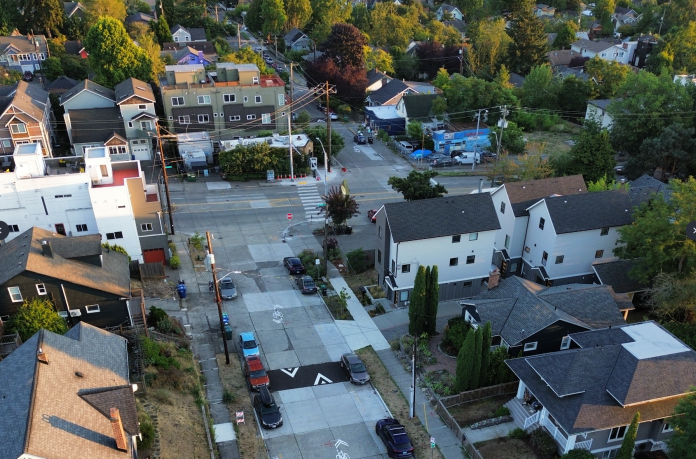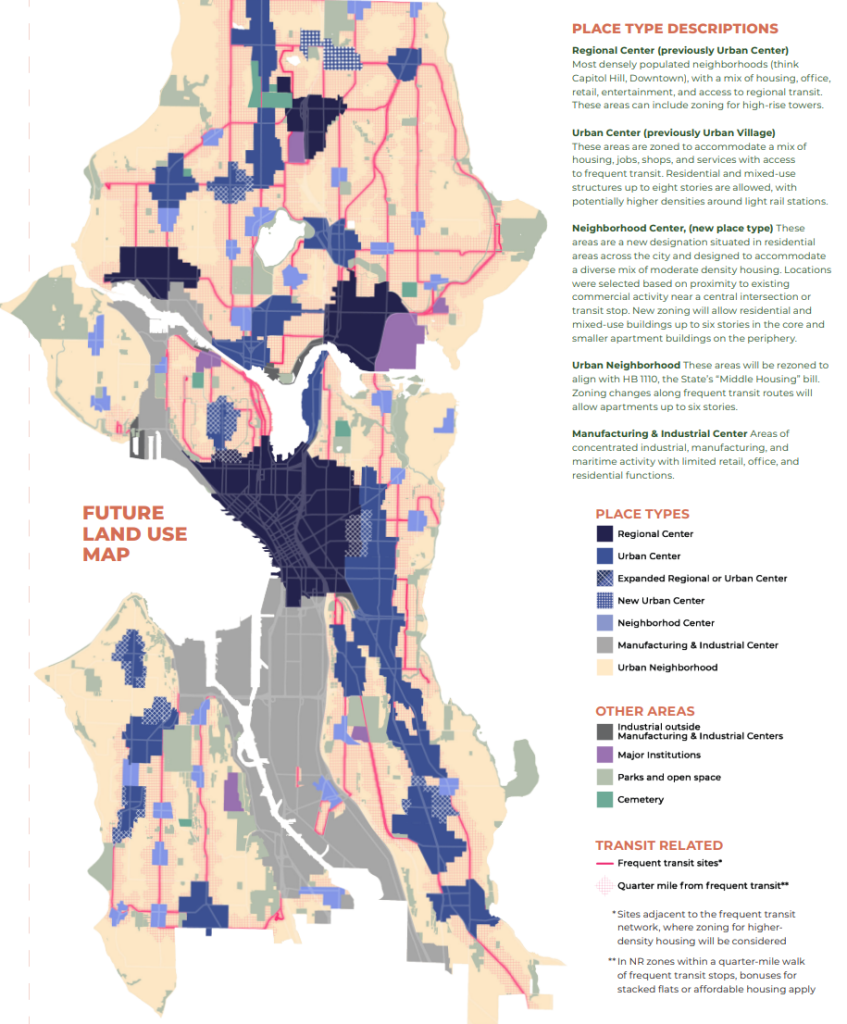
Seattle’s Hearing Examiner has dismissed all six appeals that were filed by homeowner groups against the environmental review of the city’s Comprehensive Plan update, weeks before a lengthy appeal hearing had been set to take place. The decision was detailed in a filing released late Friday afternoon.
While active appeals were pending, the Seattle City Council had been prevented from taking action on the plan. But now that those appeals have been rendered inert, legislation can advance unencumbered — at least barring the appellants appealing the decision to a higher court.
Mayor Bruce Harrell’s One Seattle Comprehensive Plan is the city’s blueprint for growth over the next two decades, and spells out areas of the city where additional housing density would be allowed. On top of modest increases in housing options across the entire city, which were mandated by the state legislature via House Bill 1110 in 2023, the plan includes 30 new neighborhood centers — small clusters of focused growth where larger apartment buildings would be allowed. The mayor’s proposal would also allow apartment buildings on the blocks directly along the city’s most frequent transit lines.
While the appeals were active, the council had pivoted forward with a temporary zoning ordinance intended to meet the state’s HB 1110 deadline to allow four or six units on lots citywide by the end of June. That stopgap measure is missing several key provisions of the One Seattle Plan, including a density bonus to encourage stacked flats on single family lots and an affordability bonus program, because those issues were tied up in the environmental review under appeal. Now, Council appears to have plenty of time to act on permanent legislation, but the exact schedule for implementation of that is not yet known.
“Councilmember Hollingsworth’s team is working with Council Central Staff today to establish a path forward on the Comprehensive Plan. Hopefully they can follow back up later today or early tomorrow with a statement,” Seattle Council spokesperson Brad Harwood told The Urbanist Monday.
The appeals, filed by individual residents and advocacy groups in exclusive neighborhoods like Madison Park, Mount Baker, Hawthorne Hills, and Ravenna-Cowen, argued that the city’s published environmental review wasn’t rigorous enough and didn’t consider specific local impacts on their areas. Among the issues raised: increased stormwater runoff, potential demolition of historic buildings, increased traffic from additional development, and negative impacts on the city’s tree canopy. One of the appeals, filed by musician Jennifer Godfrey, specifically argued that the city didn’t adequately consider the impacts of the One Seattle Plan on Washington’s population of Southern Resident killer whales.

None of those issues gained traction or won a day in appeals court thanks to a 2022 state “safe harbor” law that exempts actions taken by local governments to increase housing capacity from appeals under the State Environmental Policy Act (SEPA). Senate Bill 5818 ensures that environmental reviews for proposals seeking to meet state housing requirements or goals can’t be appealed under SEPA and that the Hearing Examiner must dismiss any appeals filed on those grounds. The One Seattle Plan met this condition by allowing middle housing on all residential lots in the city, as required under HB 1110.
“The record demonstrates that the One Seattle Proposal will authorize fourplexes and sixplexes in zones where they are not currently allowed […] and no Appellant disputed this. Thus, there is no issue of material fact regarding this issue, and the appeals should be dismissed,” Hearing Examiner Ryan Vancil wrote in the final order dismissing the appeals.
City Attorney Ann Davison’s office, which filed a motion in March to dismiss the appeals on behalf of the Office of Planning and Community Development (OPCD), noted these recent laws. “Tellingly, almost all the issues raised by Appellants relate to the proposed increases in housing capacity. These are the exact type of appeals that the legislature wants to prohibit,” the motion read.
Many of the appeals — but not all — would have also been dismissed for a completely different reason: their filers did not comment on the draft environmental impact statement (EIS) that was released in 2024. Under state law, having commented on a draft EIS is a prerequisite for being able to file an appeal after the final EIS is released. In four of the six appeals, no one involved in the appeal commented during the EIS’s comment period.

Several of the appellants, in pushing back on this argument, explicitly acknowledged that they didn’t comment, but asserted that the city did not do a good enough job contacting interested parties individually.
“Friends of Madison Park is easily Googled,” Octavia Chambliss, that group’s President, told Vancil last month. “We have a website. We have newsletters that reach over 1,000 people. There was never a public notice, no signage, no outreach to me or to the community.”
While Friends of Madison Park overlooked the opportunity to comment, many Seattleites did not; OPCD received more than 6,000 public comments on the draft One Seattle Plan in spring 2024 alone, with another round of comments on the final plan as well.
But in a brief hearing on the motion to dismiss held in March, Vancil raised an eyebrow at the fact that most of the appellants had not followed this step. The One Seattle Plan impacts every single parcel in the entire city, and a requirement to individually contact households is not in fact the standard that the City of Seattle has to meet.
“I even commented on it because I do recognize some of your citizen group names, and some of you, I’m used to seeing sophisticated citizens groups come in,” Vancil said. “It was my assumption you had all commented on the DEIS, because that’s how you get a ticket to keep playing in the game.”
The relatively quick dismissal after less than two months demonstrates the effectiveness of recent state reforms intended to stop predatory appeals under SEPA. In 2017, when a group of advocacy organizations including the Wallingford Community Council and the so-called “Seattle Coalition for Affordability, Livability, and Equity” (SCALE) appealed the environmental review for Seattle’s Mandatory Housing Affordability program, that appeal wasn’t resolved until over a year later. While these appeals aren’t the first to take advantage of updates to SEPA exemptions, they are a high-profile example.
Without those changes, Seattle’s entire housing plan would likely continue to be litigated at the Hearing Examiner instead of the city council for several more months at least. Now this episode appears to be only a brief detour, rather than a full-on derailing of the plan. Seattle’s growth plan — officially due by the end of 2024 — has already been heavily delayed by internal disputes and indecision within the Harrell Administration.
Clarification: At 10:30am Monday, the piece was updated to note that the appellants could appeal the Hearing Examiner’s decision. At 12pm Monday, a statement from the Seattle City Council was added.
Ryan Packer has been writing for The Urbanist since 2015, and currently reports full-time as Contributing Editor. Their beats are transportation, land use, public space, traffic safety, and obscure community meetings. Packer has also reported for other regional outlets including Capitol Hill Seattle, BikePortland, Seattle Met, and PubliCola. They live in the Capitol Hill neighborhood of Seattle.


